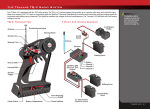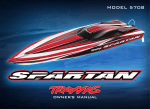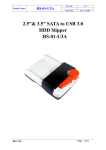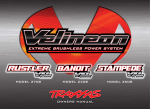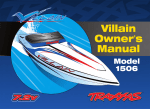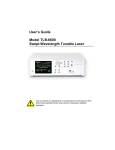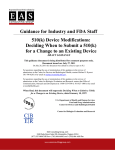Download Slash 2WD
Transcript
MODEL 5805 owners manual Introduction 3 Before You Proceed 4 Safety Precautions 5 Tools, Supplies and Required Equipment 6 Anatomy of the Slash 7 Quick Start: Getting Up to Speed 8 Decorating Your Model 9 The Traxxas TQ Radio System 15 Adjusting the Electronic Speed Control 17 Driving Your Model 19 Adjusting Your Model 22 Maintaining Your Model 23 Troubleshooting Thank you for purchasing a Traxxas Slash. The Traxxas Slash ShortCourse Race Truck puts you in the drivers seat for intense fenderto-fender, high-flying off-road action. The full-scale Short-Course Race Trucks embody the spirit of Traxxas R/C with their extreme 800+ horsepower racing engines full-throttle, dirt-roosting power slides, giant suspension travel, and Supercross-style big-air jumps. The Traxxas Slash brings all the action home so you can experience the high-speed head-to-head competition at the track or in your own backyard. The Slash was inspired by full-scale rear-wheel drive trucks purpose built to fly over jumps and rip full-throttle through the turns. The Traxxas Slash hangs it out for an all new way to challenge your driving skills. The 4-wheel independent suspension has been carefully tuned to replicate the full-scale driving and handling experience as closely as possible. The scale appearing tires provide just the right amount of bite and thick, blinding clouds of dirt roost. We know you’re excited about getting your new model on the road, but it’s very important that you take some time to read through the Owners Manual. This manual contains all the necessary set-up and operating procedures that allow you to unlock the performance and potential that Traxxas engineers designed into your model. Even if you are an experienced R/C enthusiast, it’s important to read and follow the procedures in this manual. We want you to feel confident that you own one of the bestperforming models in the market and that it is backed by a team of professionals who aim to provide the highest level of factory support possible. Traxxas models are about experiencing total performance and satisfaction, not just with your model, but also with the company that stands behind it. We truly want you to enjoy your new model! Thank you again for going with Traxxas. 2 • Slash Traxxas Support Traxxas support is with you every step of the way. Refer to the next page to find out how to contact us and what your support options are. Quick Start This manual is designed with a Quick Start path that outlines the necessary procedures to get your model up and running in the shortest time possible. If you are an experienced R/C enthusiast you will find it helpful and fast. Be sure and read through the rest of the manual to learn about important safety, maintenance, and adjustment procedures. Turn to page 7 to begin. Before You Proceed Carefully read and follow all instructions in this and any accompanying materials to prevent serious damage to your model. Failure to follow these instructions will be considered abuse and/or neglect. Support Before running your model, look over this entire manual and examine the model carefully. If for some reason you decide it is not what you wanted, then do not continue any further. Your hobby dealer absolutely cannot accept a model for return or exchange after it has been run. Technical support is available Monday through Friday from 8:30am to 9:00pm central time. Technical assistance is also available at Traxxas.com. You may also e-mail customer support with your question at [email protected]. Join thousands of registered members in our online community at Traxxas.com. Warnings, helpful hints, & cross-references An important warning about personal safety or avoiding damage to your model and related components. Traxxas offers a full-service, on-site repair facility to handle any of your Traxxas service needs. Maintenance and replacement parts may be purchased directly from Traxxas by phone or online at www.BuyTraxxas.com. You can save time, along with shipping and handling costs, by purchasing replacement parts from your local dealer. Special advice from Traxxas to make things easier and more fun. Do not hesitate to contact us with any of your product support needs. We want you to be thoroughly satisfied with your new model! Throughout this manual, you’ll notice warnings and helpful hints identified by the icons below. Be sure to read them! If you have any questions about your model or its operation, call the Traxxas Technical Support line toll-free at: 1-888-TRAXXAS (1-888-872-9927)* Refers you to a page with a related topic. *Toll-free support is available to U.S. residents only. Traxxas 1100 Klein Road Plano, Texas 75074 Phone: 972-265-8000 Toll-free 1-888-TRAXXAS Traxxas U.K. P.O. Box 1128 Winterbourne, Bristol BS36-2SH England Phone: 44-117-956-1002 Internet Traxxas.com E-mail: [email protected] Entire contents ©2008 Traxxas. Traxxas, Ready-To-Race, ReadyTo-Win, Slash and ProGraphix are trademarks or registered trademarks of Traxxas. Other brand names and marks are the property of their respective holders and are used only for purposes of identification. No part of this manual may be reproduced or distributed in print or electronic media without the express written permission of Traxxas. Specifications are subject to change without notice. Slash • 3 Safety Precautions All instructions and precautions outlined in this manual should be strictly followed to ensure safe operation of your model. All of us at Traxxas want you to safely enjoy your new model. Operate your model sensibly and with care, and it will be exciting, safe, and fun for you and those around you. Failure to operate your model in a safe and responsible manner may result in property damage and serious injury. The precautions outlined in this manual should be strictly followed to help ensure safe operation. You alone must see that the instructions are followed and the precautions are adhered to. Important Points to Remember This model is not intended for use by children under 8 years of age without the supervision of a responsible and knowledgeable adult. Your model is not intended for use on public roads or congested areas where its operation can conflict with or disrupt pedestrian or vehicular traffic. Never, under any circumstances, operate the model in crowds of people. Your model is very fast and could cause injury if allowed to collide with anyone. Because your model is controlled by radio, it is subject to radio interference from many sources that are beyond your control. Since radio interference can cause momentary losses of radio control, always allow a safety margin in all directions around the model in order to prevent collisions. The motor, battery, and speed control can become hot during use. Be careful to avoid getting burned. Don’t operate your model at night, or anytime your line of sight to the model may be obstructed or impaired in any way. Most importantly, use good common sense at all times. Batteries and Charging No previous experience with radio controlled models is required. Models require a minimum of setup, maintenance, or support equipment. Your model uses rechargeable batteries that must be handled with care for safety and long battery life. Make sure to read and follow all instructions and precautions that were provided with your battery packs and your charger. It is your responsibility to charge and care for your battery backs properly. In addition to your battery and charger instructions, here are some more tips to keep in mind. Never leave batteries to charge unattended. Remove the batteries from the model while charging. Always unplug the battery from the electronic speed control when the model is not in use and when it is being stored or transported. Allow the battery packs to cool off between runs (before charging). Do not use battery packs that have been damaged in any way. Do not use battery packs that have damaged wiring, exposed wiring, or a damaged connector. Children should have responsible adult supervision when charging and handling batteries. Speed Control General Precautions Disconnect the Batteries: Always disconnect the battery pack from the speed control when not in use. Transmitter on First: Switch on your transmitter first before switching on the speed control to prevent runaways and erratic performance. 4 • Slash Don’t Get Burned: The transistor tabs and the heat sinks can get extremely hot, so be careful not to touch them until they cool. Supply adequate airflow for cooling. Always Use Heat Sinks: Three heat sinks are factory-installed on the speed control and must be used for maximum cooling and performance. 4 to 8-Cells Only: The XL-5 can only accept a maximum input voltage of 9.6 volts. Always adhere to the minimum and maximum limitations of the XL-5 as stated in the specifications table. Use Stock Connectors: If you decide to change the battery or motor connectors, only change one battery or motor connector at a time. This will prevent accidentally mis-wiring the speed control. If the XL-5 is not wired exactly as shown in the diagram, it can be damaged! Please note that modified speed controls can be subject to a rewiring fee when returned for service. No Reverse Voltage: The speed control is not protected against reverse polarity voltage. When changing the battery and/or motor, be sure to install the same type of connectors to avoid reverse polarity damage to the speed control. Removing the battery connectors on the speed control or using the samegender connectors on the speed control will void the product’s warranty. Do Not Let the Transistor Tabs Touch: Never allow the three separate transistor banks to touch each other or any exposed metal. This will create a short circuit and damage the speed control. (For example, laying a metal tool across the heatsinks can damage the speed control.) Advanced Precautions Motor Limit: The XL-5 has a 15-turn modified motor limit for 540 size motor and a 12-turn modified motor limit for 550 size motor when the motor is properly geared. If the motor or speed control is overheating, try a smaller pinion gear. Do not attempt to use a more powerful motor (fewer turns) than the above mentioned motor limits or you could experience frequent thermal shutdown. Insulate the Wires: Always insulate exposed wiring with heat shrink tubing to prevent short circuits. Use Neutrally Timed Motor: For reverse use, the motor must have 0° timing. Modified motor (with adjustable end bells) timed to 0° or Johnson/ Mabuchi (closed end bell) motor are recommended. Using motor with other than 0° timing will draw excess current in reverse, and can result in the speed control overheating and premature motor wear. Motor Capacitors Required: Ceramic capacitors should be properly installed on every motor to prevent radio interference. These are already installed on the factory Titan motor. No Schottky Diodes: External schottky diodes are not compatible with reversing speed controls. Using a schottky diode with the XL-5 will damage the ESC and void the 30-day warranty Tools, Supplies and Required Equipment Your model comes with a set of specialty metric tools. You’ll need to purchase other items, available from your hobby dealer, to operate and maintain your model. Supplied Tools and Equipment 2.5mm “L” wrench Optional Pinion Gear see page 20 2.0mm “L” wrench Antenna nut wrench 1.5mm “L” wrench Aftermarket servo adapters Pre-load spacers and shock pistons (on parts tree) see page 19 Required Tools and Equipment 8 AA alkaline batteries 6 or 7-cell NiMH battery pack with Traxxas High-Current Connector U-joint wrench Turnbuckle wrench Body clips and body washers 4-way wrench Battery hold-down pad (to reduce battery vibration, if necessary) (sold separately) NiMH battery charger (peak detecting type recommended) see sidebar For more information on batteries, see Use the Right Batteries on page 11. A peak-detecting charger is recommended for best performance and longest battery life. For more information, see Use the Right Charger on page 10. Recommended Equipment These items are not required for the operation of your model, but are a good idea to include in any R/C toolbox: • Safety glasses • Thin, hobby-quality cyanoacrylate instant tire glue (CA glue) • Hobby knife • Side cutters and/or needle nose pliers • Philips screwdriver • Soldering iron Charging adapter - Traxxas part #3061 (if your battery charger has a Molex connector) Slash • 5 Anatomy of the Slash Turnbuckle (Rear Camber Link) Steering Block Electronic Speed Control (XL-5) Chassis Half Shaft Rear Body Mount Antenna Mount Front Body Mount Battery Hold-Down Receiver Box Front Shock Tower Motor (Titan 12T) Caster Block Suspension Arm (Front) Front Bumper Transmission Rear Bumper Shock (Oil Damper) Pinion Gear Nerf Bar Spur Gear Slipper Clutch Suspension Arm (Rear) 6 • Traxxas Traxxas HighCurrent Connector Battery Compartment Rear Shock Tower Steering Servo Turnbuckle (Front Camber Link) Turnbuckle (Toe Link) Quick Start: Getting up to Speed The following guide is an overview of the procedures for getting your model running. Look for the Quick Start logo on the bottom corners of Quick Start pages. 1. Read the safety precautions on page 4 For your own safety, understand where carelessness and misuse could lead to personal injury. 2. Charge the battery pack • See sidebar, page 10 Fully charge a 7.2-volt battery pack (not included). Charge your battery now so it will be ready when you finish the other setup procedures. 3. Install the antenna • See page 12 Install the antenna mast in the model. 4. Install batteries in the transmitter • See page 11 The transmitter requires 8 AA alkaline or rechargeable batteries. 5. Install battery pack in the model • See page 11 Your model requires a fully charged 7.2-volt battery pack (not included). 7. Check servo operation • See page 14 Make sure the steering servo is working correctly. 8. Range test the radio system • See page 14 Follow this procedure to make sure your radio system works properly at a distance and that there is no interference from outside sources. The Quick Start Guide is not intended to replace the full operating instructions available in this manual. Please read this entire manual for complete instructions on the proper use and maintenance of your model. 9. Detail your model • See page 8 Apply other decals if desired. 10. Drive your model • See page 17 Driving tips and adjustments for your model. 11. Maintaining your model • See page 22 Follow these critical steps to maintain the performance of your model and keep it in excellent running condition. 6. Turn on the radio system • See page 14 Make a habit of turning the transmitter on first, and off last. Look for the Quick Start logo at the bottom of Quick Start pages. Slash • 7 Decorating Your Model Applying The Decals Tire Gluing The main decals for your model have been applied at the factory. The decals are printed on self-adhesive clear mylar and are die-cut for easy removal. Use a hobby knife to lift the corner of a decal and lift it from the backing. To apply the decals, place one end down, hold the other end up, and gradually smooth the decal down with your finger as you go. This will prevent air bubbles. Placing both ends of the decal down and then trying to smooth it out will result in air pockets. Look at the photos on the box for typical decal placement. The factory tires on your model are already glued to the rims. The tires must be glued to the rims to prevent the rims from spinning inside the tires. The instructions here are provided to show you how to glue replacement tires to the rims in the future. Use CA tire glue available from your local hobby dealer. 1. Remove a wheel from your model using the 4-way wrench. 2. Use your thumb to push the side of the tire away from the rim. Place one or two drops of CA glue into the opening and release the tire. Capillary action will draw the glue around the bead of the tire. 3. Repeat step two at four or five points around the rim, until the tire is completely secured to the rim. Turn the rim over and repeat the process for the inside of the rim/tire. Repeat for the other three wheels. 4. Reinstall the wheels. Make sure none of the axle pins have fallen out from behind the hex hubs. 8 • Slash The Traxxas TQ Radio System Your model is equipped with the Traxxas TQ Radio System. The Traxxas TQ Radio System is a 2-channel system that provides high-power output up to a quarter mile. Your model uses one servo and an electronic speed control. Wiring Diagram Motor (Titan® 12T) Antenna Receiver TQ Transmitter Antenna Throttle Neutral Adjust Steering Wheel XL-5 Electronic Speed Control Channel 2 Throttle Trim Steering Trim The following Traxxas High Current Connector packages are available from your hobby dealer. When using adapters, be careful not to exceed the current rating of the Molex connector. See page 11 for more information. Part #3060 Single Male/Female Part #3080 2-Pack Female Part #3061 Male Charge Adapter Part #3070 2-Pack Male Traxxas High-Current Connector (Male) to Battery * Not Used Steering Servo Channel 1 XL-5 Electronic Speed Control Part #3062 Female Charge Adapter To Motor Throttle Trigger Traxxas High-Current Connector (Male) to Battery Servo Reversing Switch CH.2 CH.1 Heat Sinks Power Switch Battery Compartment Power Indicator LED Set Button Slash • 9 The Traxxas TQ Radio System Radio and Power System Terminology Use the Right Charger The most convenient type of charger is an AC peakdetecting charger that plugs directly into an AC wall outlet. It contains special peak-detection circuitry that automatically shuts the charger off when the battery is fully charged. If you’re using a 15-minute timed charger, always fully discharge the battery pack before each charge. Some high mAh battery packs (1500 mAh or higher) require more than the standard 15 minutes of charge time. If the battery pack is cold after 15 minutes of charging, add another 5 minutes of charge time. Closely monitor the battery pack and stop charging it when it begins to feel warm to the touch. Never leave a battery charging unattended. Always follow charger manufacturer’s instructions. 10 • Slash Please take a moment to familiarize yourself with these radio and power system terms. They will be used throughout this manual. BEC (Battery Eliminator Circuit) - The BEC can either be in the receiver or in the ESC. This circuit allows the receiver and servos to be powered by the main battery pack in an electric model. This eliminates the need to carry a separate pack of 4 AA batteries to power the radio equipment. Channel - The 27 MHz frequency band is divided into 6 channels so that up to six models can be operated simultaneously. Each channel is referred to by its flag color and channel number, as shown below. 1 Frequency Band 26.995 2 27.045 3 27.095 Orange 2033 4 27.145 Yellow 2034 5 27.195 Green 2035 6 27.255 Blue 2036 Channel Flag Color Brown Traxxas Part No. 2031 Red 2032 Clearing your frequency - A routine, verbal check to make sure nobody else in your area is operating on the same channel. Always clear your frequency by calling out your channel number before operating your model. Wait or move to another area if your channel is already being used. Crystal (X-tal) - The plug-in device that determines which channel the radio system will operate on. For each channel, there are two crystals, one for the receiver and one for the transmitter. Of those two crystals, the one marked with the lower number (.455 MHz lower) must be inserted into the receiver. Current - Current is a measure of power flow through the electronics, usually measured in amps. If you look at wire like a garden hose, current is a measure of how much water is flowing through the hose. ESC (Electronic Speed Control) - An electronic speed control is the electronic motor control inside the model. The XL-5 uses MOSFET power transistors to provide precise, digital proportional throttle control. Electronic speed controls use power more efficiently than mechanical speed controls so that the batteries run longer. An electronic speed control also has circuitry that prevents loss of steering and throttle control as the batteries lose their charge. Frequency band - The radio frequency used by the transmitter to send signals to your model. All Traxxas RTR models operate on a 27 MHz frequency band. mAh – Abbreviation for milliamp hour. A measure of the capacity of the battery pack. The higher the number, the longer the battery will last between recharges. Neutral position - The standing position that the servos seek when the transmitter controls are at the neutral setting. NiCad - Abbreviation for nickel-cadmium. The original rechargeable hobby pack, NiCad batteries have very high current handling, high capacity, and can last up to 1000 charging cycles. Good charging procedures are required to reduce the possibility of developing a “memory” effect and shortened run times. NiMH - Abbreviation for nickel-metal hydride. Rechargeable NiMH batteries offer high current handling, and much greater resistance to the “memory” effect. NiMH batteries generally allow higher capacity than NiCad batteries. They can last up to 500 charge cycles. A peak charger designed for NiMH batteries is required for optimal performance. Receiver - The radio unit inside your model that receives signals from the transmitter and relays them to the servos. Resistance - In an electrical sense, resistance is a measure of how an object resists or obstructs the flow of current through it. When flow is constricted, energy is converted to heat and is lost. Servo - Small motor unit in your model that operates the steering mechanism. Transmitter - The hand-held radio unit that sends throttle and steering instructions to your model. Trim - The fine-tuning adjustment of the neutral position of the servos, made by adjusting the throttle and steering trim sliders on the face of the transmitter. Thermal Shutdown Protection - Temperature sensing electronics are used in the ESC to detect overloading and overheating of the transistor circuitry. If excessive temperature is detected, the unit automatically shuts down to prevent damage to the electronics. 2-channel radio system - The TQ radio system, consisting of the receiver, the transmitter, and the servos. The system uses two channels: one to operate the throttle and one to operate the steering. Voltage - Voltage is a measure of the electrical potential difference between two points, such as between the positive battery terminal and ground. Using the analogy of the garden hose, while current is the quantity of water flow in the hose, voltage corresponds to the pressure that is forcing the water through the hose. The Traxxas TQ Radio System Installing Transmitter Batteries Using Different Battery Configuration The battery hold-downs are capable of accommodating either side-byside racing style packs or the more common stick packs. The battery compartments are configured for stick packs from the factory. The number on each side of the hold down indicates the battery height in millimeters that hold-down can accommodate. Note that one side is labeled “25” and other side is labeled “23”. The 25mm side is for use with typical stick type battery packs. If you are using side-by-side racing packs, simply flip the hold-down over to the 23mm side and use it on the opposite side of the chassis. Your TQ transmitter uses 8 AA batteries. The battery compartment is located in the base of the transmitter. 1.Remove the battery compartment door by pressing the tab and lifting the door up. 2.Install the batteries in the correct orientation as indicated in the battery compartment. 3.Reinstall the battery door and snap it closed. 4.Turn on the transmitter and check the power indicator for a solid red light. If the power indicator light flashes, then the transmitter batteries are weak, discharged or possibly installed incorrectly. Replace with new or freshly charged batteries. The power indicator light does not indicate the charge level of the battery pack installed in the model. 25mm side: Standard NiMH stick pack setup 23mm side: Side-by-side NiMH pack setup CH.1 CH.2 Installing the Battery Pack Install the battery pack with the battery wires facing the rear of the model. Your model includes a foam block which should be installed in front of 6-cell batteries for a more secure fit. Remove the foam block for use with 7-cell “flat” packs. Insert the tabs of the battery hold-down into the Foam Block slots in the rear hold-down retainer and then place the battery hold-down over the post. Secure the battery hold-down with body clip in the hole in the post. Do not connect the battery pack yet. The Traxxas High Current Connector Your model is equipped with the Traxxas HighCurrent Connector. Standard connectors restrict current flow and are not capable of delivering the power needed to maximize the output of the XL-5. The Traxxas connector’s gold-plated terminals with a large contact surfaces ensure positive current flow with the least amount of resistance. Secure, long-lasting, and easy to grip, the Traxxas connector is engineered to extract all the power your battery has to give. To run this model, your batteries must be equipped with Traxxas High-Current Connectors. Batteries can either be purchased new with Traxxas connectors installed or Traxxas connectors can be purchased to install on battery packs you already own. See sidebar on page 9 for packages available from your hobby dealer. The typical Molex style connector is inadequate for use in your model. It creates resistance that becomes a bottleneck to current flow. If your battery pack is equipped with a Molex connector, it must be replaced with a Traxxas High-Current Connector to mate with the XL-5 electronic speed control. Use the Right Batteries Your transmitter uses AA batteries. Use new alkaline batteries, or rechargeable batteries such as NiCad or NiMH (Nickel Metal Hydride) batteries in your transmitter. Make sure rechargeable batteries are fully charged according to the manufacturer’s instructions. If you use rechargeable batteries in your transmitter, be aware that when they begin to lose their charge, they lose power more quickly than regular alkaline batteries. Caution: Discontinue running your model at the first sign of weak batteries (flashing red light) to avoid losing control. If the power indicator doesn’t light red, check the polarity of the batteries. Check rechargeable batteries for a full charge. Molex connector Slash • 11 The Traxxas TQ Radio System Setting up the Antenna If there are any kinks in the black antenna wire, it will be more difficult to push through the antenna tube. Pull the wire straight by sandwiching it between your thumb and index finger and running your fingers along the length of the wire (with medium pressure). Don’t shorten the length of the antenna wire. Its length is tuned to the frequency band; cutting it could severely shorten the radio system’s range. Don’t push the transmitter antenna down from the top. Pull it down from the bottom, one segment at a time, to prevent binding and kinking the antenna mast. Steering NL TUR EFT Antenna Tip 1.Remove the antenna tip. 2.Pull the slack wire through the antenna tube, and then insert the base of the antenna tube into the antenna post on the receiver box. Take care not to crimp the antenna wire. Antenna Tube Brake/Reverse 3. Slide the crimp nut over the antenna tube and screw it into the antenna post. Slide the antenna wrench over the antenna tube and tighten the crimp nut on the post just until the antenna tube is securely in place. Do not over tighten or crush the antenna wire against the chassis. 4. Fold the top of the antenna wire over the top of the antenna tube. Slide the antenna tip onto the top of the antenna tube. Never cut or shorten the antenna wire. 5. On the transmitter, always fully extend the telescoping antenna when running your model. Make a habit of holding the transmitter so the antenna points straight up. RN RIGHT TU Spray a little window cleaner on the antenna wire to make it easier to push through the antenna tube. TQ Radio System Controls You must install the antenna mast (tube) before you operate your model. You’ll find the assembled plastic antenna tube and tip laying in the chassis. Neutral Antenna Wrench CH.1 CH.2 Accelerate Antenna Crimp Nut TQ Radio System Adjustments In addition to the electronic throttle and steering trim controls, your radio system features throttle neutral adjustment and servo reversing switches. These are preset at the factory and should not require further adjustment. Throttle Neutral Adjustment The throttle neutral adjustment is located on the transmitter face and controls the forward/reverse travel of the throttle trigger. Change the adjustment by pressing the button and sliding it to the desired position. 12 • Slash The Traxxas TQ Radio System There are two settings available: 50/50: Allows equal travel for both acceleration and reverse. 70/30: Allows more throttle travel (70%) and less reverse travel (30%). Note: If you change throttle travel, you will need to reprogram the electronic speed control. Electronic Throttle Trim The electronic throttle trim located on the face of the transmitter adjusts the neutral (center) point of the throttle servo when the servo is at rest. Your model uses an electronic speed control instead of a throttle servo, this control has been preset for you at the factory. Electronic Steering Trim The electronic steering trim located on the face of the transmitter adjusts the neutral (center) point of the steering servo when the servo is at rest. Adjust this control to make the model drive straight with no steering input at the wheel. Servo Reversing Switches The servo reversing switches are located on the front of the transmitter, next to the on/off switch. Moving a switch reverses the direction of the corresponding servo. CH.2 CH.1 Each switch corresponds to a channel, as shown below. For example, if you turn the steering wheel to the right and your wheels turn left, you would move the Channel 1 switch to correct the servo direction. It may be necessary to adjust the corresponding trim control after moving a switch. Channel Servo 1 Steering 2 Throttle CH.2 CH.1 Default Setting Slash • 13 The Traxxas TQ Radio System TQ Radio System Rules Remember, always turn the TQ transmitter on first and off last to avoid damage to your model. Your speed control was adjusted to the radio from the factory. It is possible for the throttle trim control on the transmitter to have moved during transit or while handling the transmitter. If the motor runs when the model is switched on, then move the throttle trim control on the transmitter until the motor stops. If anything more than a slight adjustment of the throttle trim control is required, then you should readjust your speed control. Refer to the adjustments section on page 15. Channel 1 Brown Each time you prepare to run your model, you must clear your frequency to be sure no one else in the area is using the same channel as you. There are six possible channels, numbered 1 through 6. Each is represented by a color. Look at the crystal plugged into the back of your transmitter to determine which channel your model is assigned to. Channel 2 Red Channel 3 Orange Channel 4 Yellow Channel 5 Green Always turn your TQ transmitter on first and off last. This procedure will help to prevent your model from receiving stray signals from another transmitter, or other source, and running out of control. Channel 6 Blue Always have the transmitter turned on before plug in the battery. Always use new or freshly charged batteries for the radio system. Weak batteries will limit the range of the radio signal between the receiver and the transmitter. Loss of the radio signal can cause you to lose control of your model. 2 1 3 3.Plug the battery pack in the model into the speed control. 4.The on/off switch is integrated into the speed control. With the transmitter on, press the XL-5 set button for ½ second, until the LED shines GREEN, then immediately release the button. This turns the model on (see page 15 for more on XL-5 setup and operation). To turn the XL-5 off, press the set button until the green LED turns off. 5.Turn the steering wheel on the transmitter back and forth and check for rapid operation of the steering servo. Also, check that the steering mechanism is not loose or binding. If the steering operates slowly, check for weak batteries. 6.When looking down at model, the front wheels should be pointing straight ahead. If the wheels are turned slightly to the left or right, slowly adjust the steering trim control on the transmitter until they are pointing straight ahead. 7.Operate the throttle trigger to ensure that you have full forward and reverse operation, and that the motor stops when the throttle trigger is at neutral. 8.Once adjustments are made, turn off your model, followed by the hand held transmitter. Range-Testing the TQ Radio System Before each running session with your model, you should rangetest your radio system to ensure that it operates properly. CH.1 CH.2 When rechargeable batteries begin to lose their charge, they will fade much faster than alkaline dry cells. Stop immediately at the first sign of weak batteries. Never turn the transmitter off when the battery pack is plugged in. The model could run out of control. Always turn your transmitter on first. Plug in the battery. Turn on the model. see TQ Radio System Setup, step 4. TQ Radio System Setup The TQ Radio System was pre-adjusted at the factory. The adjustment should be checked, before running the model, in case of movement during shipping. Here’s how: 1.Fully extend the chrome antenna mast on the transmitter and turn the switch on. The red indicator light on the transmitter should be solid red (not flashing). 2.Elevate the model so that the rear tires are off the ground. If you are holding the model, grip it firmly. Make sure your hands are clear of the moving parts of the model. 14 • Slash 1. Turn on the radio system and check its operation as described in the previous section. 2. Have a friend hold the model. Make sure hands and clothing are clear of the wheels and other moving parts on the model. 3. Make sure your transmitter antenna is fully extended, and then walk away from the model with the transmitter until you reach the farthest distance you plan to operate the model. 4. Operate the controls on the transmitter once again to be sure that the model responds correctly. 5. Do not attempt to operate the model if there is any problem with the radio system or any external interference with your radio signal at your location. Adjusting the Electronic Speed Control XL-5 electronic speed controls are factory set and should not require any adjustments. These instructions are provided for your reference. Transmitter Adjustments for the XL-5 ESC Before attempting to program your XL-5 ESC, it is important to make sure that your transmitter is properly adjusted (set back to the factory defaults). Otherwise, you may not get the best performance from your speed control. The transmitter should be adjusted as follows: 1. Set the throttle neutral switch to the 50/50 setting. 2. Set the throttle trim to the middle “0” setting. This adjusts the neutral position. 3. Set the Channel 2 servo reversing switch to the left position. 4. Do not change the position of any of the servo reversing switches after programming the XL-5 ESC. XL-5 Setup Programming (Calibrating your ESC and transmitter) Read through all of the programming steps before you begin. If you get lost during programming or receive unexpected results, simply unplug the battery, wait a few seconds, plug the battery back in, and start over. 1. Disconnect one of the motor wires between the XL-5 and the motor. This is a precaution to prevent runaway when the speed control is turned on before it is programmed. 2. Connect a fully charged battery pack to the XL-5. A Green then Red B 3. Turn on the transmitter (with the throttle at neutral). 4. Press and hold the ESC set button (A). The LED will first turn green and then red. Release the set button. Once Red C Twice Red 7. When the LED turns solid GREEN, programming is complete. The LED will continuously shines green indicating the XL-5 is on and at neutral (D). 1. With the transmitter on, press the set button for ½ second, until the LED shines GREEN, then immediately release the button. This turns the XL-5 on. If you press and release too quickly, you may hear the steering servo jump but the LED may not stay on. Simply press the button again until the LED shines GREEN and then release. (Note: If the throttle is not at neutral or if the throttle trim has been altered, the LED will turn off after one second and the wheels may begin to drive.) 2. Apply forward throttle. The LED will turn off until full throttle power is reached. At full throttle, the led will shine GREEN. 3. Move the trigger forward to apply the brakes. Note that braking control is fully proportional. The LED will turn off until full braking power is reached. At full brakes, the LED will shine GREEN. 4. Return the throttle trigger to neutral. The LED will shine GREEN. 5. Move the throttle trigger forward again to engage reverse (Profile #1). The LED will turn off. Once full reverse power is reached, the LED will shine GREEN. 6. To stop, return the throttle trigger to neutral. Note that there is no programmed delay when changing from reverse to forward. Use caution to avoid slamming the speed control from reverse to forward. On high-traction surfaces, this could result in transmission or driveline damage. 7. To turn the XL-5 off, press the set button until the green LED turns off. XL-5 Specifications Input voltage: 4 to 8 cells (4.8 to 9.6V) Motor limit: 15-turns (540) 12-turns (550) Peak current - fwd/rev: 60A/60A Braking current: 60A BEC voltage: 6V Transistor type: MOSFET Battery connector: Traxxas High-Current Connector XL-5 Wiring Diagram Thermal Shutdown Protection The XL-5 is equipped with thermal shutdown protection to guard against overheating caused by excessive current flow. If the operating temperature exceeds safe limits, the XL-5 will automatically shut down. The LED on the face of the XL-5 will continuously shine green, even if the throttle trigger is moved back and forth. Once the temperature returns to a safe level, the XL-5 will once again function normally. 5. When the LED blinks RED ONCE. Pull the throttle trigger to the full throttle position and hold it there (B). 6. When the LED blinks RED TWICE. Push the throttle trigger to the full reverse and hold it there (C). XL-5 Operation To operate the speed control and test the programming, reconnect the motor wires and place the vehicle on a stable block or stand so that all of the driven wheels are off the ground. D Solid Green XL-5 Profile Selection The speed control is factory set to Profile #1 (100% forward, brakes, and reverse). To disable reverse (Profile #2) or to allow 50% forward and 50% reverse (Profile #3), follow the steps on page 16. The speed control should be connected to the receiver and battery, and the transmitter should be adjusted as described previously. The profiles are selected by entering the programming mode. Slash • 15 Adjusting the Electronic Speed Control Patent-Pending Training Mode (Profile #3) reduces forward and reverse throttle by 50%. Training Mode is provided to reduce the power output allowing beginning drivers to better control the model. As driving skills improve, simply change to Sport or Race Mode for full-power operation. Tip For Fast Mode Changes The XL-5 is set to Profile 1 (Sport Mode) as the default. To quickly change to Profile 3 (Training Mode), with the transmitter on, press and hold the SET button until the light blinks red three times and then release. For full power, quickly change back to Profile 1 (Sport Mode) by pressing and holding the SET button until the light blinks red one time and then releasing. Profile Description Profile #1 (Sport Mode): 100% Forward, 100% Brakes, 100% Reverse Profile #2 (Race Mode): 100% Forward, 100% Brakes, No Reverse Profile #3 (Training Mode): 50% Forward, 100% Brakes, 50% Reverse Selecting Sport Mode (Profile #1: 100% Forward, 100% Brakes, 100% Reverse) 1.Connect a fully charged battery A B pack to the XL-5 and turn on your transmitter. 2. With the XL-5 off, press and hold Green to Red to Off One blink Red the set button until the light turns D solid green, then solid red and then C begins blinking red (indicating the Profile numbers). 3. When the light blinks red once, Release Solid Green release the set button. 4.The light will then turn green and the model is ready to drive. Selecting Race Mode (Profile #2: 100% Forward, 100% Brakes, No Reverse) 1.Connect a fully charged battery A B pack to the XL-5 and turn on your transmitter. 2. With the XL-5 off, press and hold the set button until the light turns Green to Red to Off Two blinks Red solid green, then solid red and then C D begins blinking red (indicating the Profile numbers). 3. When the light blinks red twice, Release Solid Green release the set button. 4.The light will then turn green and the model is ready to drive. Selecting Training Mode (Profile #3: 50% Forward, 100% Brakes, 50% Reverse) 1.Connect a fully charged battery A B pack to the XL-5 and turn on your transmitter. 2. With the XL-5 off, press and hold Green to Red to Off Three blinks Red the set button until the light turns solid green, then solid red and then C D begins blinking red (indicating the Profile numbers). 3. When the light blinks red three Release Solid Green times, release the set button. 4.The light will then turn green and the model is ready to drive. 16 • Slash Note: If you missed the mode you wanted, keep the SET button pressed down and the blink cycle will repeat until a Mode is selected. Driving your Model Now it’s time to have some fun! This section contains instructions on driving and making adjustments to your model. Before you go on, here are some important precautions to keep in mind. • Allow the model to cool for a few minutes between runs. This is particularly important when using high capacity (2400mAh and above) battery packs that allow extended periods of running. Monitoring temperatures will extend the lives of the batteries and motor. • Do not continue to operate the model with low batteries or you could lose control of it. Indications of low battery power include slow operation and sluggish servos (slow to return to center). Stop immediately at the first sign of weak batteries. When the batteries in the transmitter become weak, the red power light will begin to flash. Stop immediately and install new batteries. • Do not drive the model at night, on public streets, or in large crowds of people. • If the model becomes stuck against an object, do not continue to run the motor. Remove the obstruction before continuing. Do not push or pull objects with the model. • Because the model is controlled by radio, it is subject to radio interference from many sources beyond your control. Since radio interference can cause momentary losses of control, allow a safety margin of space in all directions around the model in order to prevent collisions. • Use good, common sense whenever you are driving your model. Intentionally driving in an abusive and rough manner will only result in poor performance and broken parts. Take care of your model so that you can enjoy it for a long time to come. • When using the supplied optional pinions for top speed running, limit your driving to paved surfaces only. Running in grass and off-road could cause excessive loads on the electrical system in the model. • The Titan 12T motor will benefit from a short break in period to ensure optimum performance and longer motor life. For the first battery pack, use the stock installed pinion gear and drive smoothly on a flat, paved surface. Accelerate smoothly (avoiding full throttle starts), with most of the driving being done at higher speeds. This will help insure that the motor provides the best performance and longest life. About Run Time A large factor affecting run time is the type and condition of your batteries. The milliamp hour (mAh) rating of the batteries determines how large their “fuel tank” is. A 3000 mAh battery pack will theoretically run twice as long as a 1500 mAh sport pack. Because of the wide variation in the types of batteries that are available and the methods with which they can be charged, it’s impossible to give exact run times for the model. Another major factor which affects run time is how the model is driven. Run times may decrease when the model is driven repetitively from a stop to top-speed and with repetitive hard acceleration. Tips for Increasing Run Time • Use batteries with the highest mAh rating you can purchase. • Use a high-quality peak-detecting charger. • Read and follow all maintenance and care instructions provided by the manufacturer of your batteries. • Vary your speed. The Titan12T is a fan cooled motor, therefore moderate to topspeed running helps reduce motor temperatures. • Lower your gear ratio. Installing a smaller pinion gear will lower your gear ratio, causing less power draw from the motor. • Maintain your model. Do not allow dirt or damaged parts to cause binding in the drivetrain. Keep the motor clean and the motor bushings lightly lubricated. mAh Ratings and Power Output The mAh rating of the battery can effect your top speed performance. The higher capacity battery packs experience less voltage drop under heavy load than low mAh rated packs. The higher voltage potential allows increased speed until the battery begins to become discharged. Running in Wet Conditions Your new Traxxas Slash is designed with water-resistant features to protect the electronics in the model (receiver, servos, electronic speed control). This gives you the freedom to have fun driving your Slash through puddles, wet grass, snow, and through other wet conditions. Though highly water resistant, the Slash should not be treated as though it is submersible or totally, 100% waterproof. Water resistance applies only to the installed electronic components. Running in wet conditions requires additional care and maintenance for the mechanical and electrical components to prevent corrosion of metal parts and maintain their proper function. Precautions • Without proper care, some parts of your model can be seriously damaged due to contact with water. Know that additional maintenance procedures will be required after running in wet conditions in order to maintain the performance of your model. Do not run your model in wet conditions if you are not willing to accept the additional care and maintenance responsibilities. • Not all batteries can be used in wet environments. Consult your battery manufacturer to see if their batteries can be used in wet conditions. Do not use LiPo batteries in wet conditions (note: the XL-5 is not LiPo compatible). • The Traxxas TQ transmitter is not water resistant. Do not subject it to wet conditions such as rain. • Do not operate your model during a rain storm or other inclement weather where lightning may be present. • Do NOT allow your model to come in contact with salt water (ocean water), brackish water (between fresh water and ocean water), or other contaminated water. Salt water is highly conductive and highly corrosive. Use caution if you plan to run your model on or near a beach. • Even casual water contact can reduce the life of your motor. Special care must be taken to modify your gearing and/or your driving style in wet conditions to extend the life of the motor (details follow). Slash • 17 Driving your Model Before Running Your Vehicle in Wet Conditions 1. Consult the section “After Running Your Vehicle in Wet Conditions” before proceeding. Make sure you understand the additional maintenance required with wet running. 2. The wheels have small holes molded in to allow air to enter and exit the tire during normal running. Water will enter these holes and get trapped inside the tires if holes are not cut in the tires. Cut two small holes (3mm or 1/8” diameter) in each tire. Each hole should be near the tire centerline, 180 degrees apart. 3. Confirm that the RX box O-ring and cover are installed correctly and secure. Make sure the screws are tight and the blue O-ring is not visible protruding from the edge of the cover. 4. Confirm that your batteries can be used in wet conditions. 5. Use lower gearing (smaller pinion gears, as low as 12T or spur gear as large as 90T) when running in mud, deep puddles, snow, or other similar situations that will restrict the tires and put much higher loads on the motor. Motor Precautions • Titan motor life can be greatly reduced in mud and water. If the motor gets excessively wet or submerged, use very light throttle (run the motor slowly) until the excess water can run out. Applying full throttle to a motor full of water can cause rapid motor failure. Your driving habits will determine motor life with a wet motor. Do not submerge the motor under water. • Do not gear the motor by temperature when running in wet conditions. The motor will be cooled by water contact and will not give an accurate indication of appropriate gearing. 18 • Slash After Running Your Vehicle in Wet Conditions 1. Drain the tires by spinning the tires at high speed to “sling” the water out. One way to do this is to make several high-speed passes on a flat, dry surface, if possible. 2. Remove the batteries. 3. Rinse excess dirt and mud off the truck with low-pressure water, such as from a garden hose. Do NOT use pressure washer or other high-pressure water. Avoid directing water into the bearings, transmission, etc. 4. Blow off the truck with compressed air (optional, but recommended). Wear safety glasses when using compressed air. 5. Remove the wheels from the truck. 6. Spray all the bearings, drivetrain, and fasteners with WD-40® or similar water displacing light oil. 7. Let the truck stand or you may blow off with compressed air. Placing the truck in a warm sunny spot will aid drying. Trapped water and oil will continue to drip from the truck for a few hours. Place it on a towel or piece of cardboard to protect the surface underneath. 8. As a precautionary step, remove the sealed receiver box cover. While unlikely, humidity or tiny amounts of moisture or condensation may enter the receiver box during wet running. This can cause long-term problems with the sensitive electronics in the receiver. Removing the receiver box cover during storage allows the air inside to dry. This step can improve the long-term reliability of the receiver. It is not necessary to remove the receiver or unplug any of the wires. 9. Additional Maintenance: Increase your frequency of disassembly, inspection and lubrication of the following items: This is necessary after extended wet use or if the vehicle will not be used for an extended period of time (such as a week or longer). This additional maintenance is needed to prevent any trapped moisture from corroding internal steel components. • Stub axle housing bearings: Remove, clean, and re-oil the bearings. • Transmission: Remove, disassemble, clean, and re-grease the transmission components. Use a light coating of wheel bearing grease (from an auto parts store) on the metal gear teeth. Refer to your exploded view diagrams for help with disassembly and reassembly. • Titan motor: Remove the motor, clean with aerosol motor cleaner, and re-oil the bushings with lightweight motor oil. Be sure to wear eye protection when using spray aerosol cleaners. Receiver Box: Maintaining a Watertight Seal Removing and Installing Radio Gear The unique design of the receiver box allows the removal and installation of the receiver without losing the ability to maintain a watertight seal in the box. The patent-pending wire clamp feature gives you the ability to also install aftermarket radio systems and maintain the watertight features of the receiver box. Removing the Receiver 1. To remove the cover, remove the two 3x8mm button-head cap screws. 2. To remove the receiver from the box simply lift it out and set to the side. The antenna wire is still inside the clamp area and cannot be removed yet. 3. Remove the wire clamp by removing the two 2.5x8mm cap screws. 4. Unplug the servo cables from the receiver and remove the receiver. Receiver Installation 1. Always install the wires into the RX box before installing the receiver. 2. Install the antenna wire and the servo cables into the receiver box. 3.Arrange the wires neatly using the wire guides in the A receiver box (A). The excess wire will be bundled inside the receiver box. Label which wire is for which channel. 4. Apply small bead of silicone grease (Traxxas part #1647) to the wire clamp (B). 5. Install the wire clamp and tighten the two 2.5x8mm cap screws securely. B 6. Install the receiver into the box and plug the wires into receiver (C). Refer to page 9 for the wiring diagram. 7. Make sure the O-ring is properly seated into the groove in the receiver box so that the cover will not pinch it or C damage it any way. 8.Install the cover and tighten the two 3x8mm buttonhead cap screws securely. 9. Inspect the cover to make sure that the O-ring seal is not visible. -1o -1o -1.5o -1.5o Adjusting your Model Once you become familiar with driving your model, you might need to make adjustments for better driving performance Adjusting the Toe-in 0o 0o Geometry and alignment specs play an important roll in your model’s handling. Take the time to set them correctly. Set Toe-in the steering trim on 0o rods so your transmitter to neutral. Now, adjust your servo and tie that both wheels are pointing straight ahead and are parallel to each other (0-degrees toe-in). This will ensure the same amount of steering in both directions. For increased stability add one- to twodegrees of toe in to each front wheel. Use the turnbuckles to adjust the alignment. -1o Adjusting the Camber 0o The camber angle of both the front and rear wheels can be adjusted with the camber rods (upper turnbuckles). Use a square or right-angle triangle to set the camber o accurately. The stock-1camber of the front wheels is -1 degree of camber. In the rear, the stock camber is -1.5 degrees. These adjustments should be set with the truck positioned at itsonormal ride 0 height with a battery installed. -1o 0o -1o Front Camber 0o -1.5o -1.5o Rear Camber 0o Fine Tuning the Shocks The four shocks on the model greatly influence its handling. Whenever you rebuild your shocks, or make any changes to the pistons, springs or oil, always make changes to them in pairs (front or rear). Piston selection depends on the range of oil viscosities that you have available. For example, using a two-hole piston with a lightweight oil will, at one point, give you the same damping as a three-hole piston with heavier oil. We recommend using the two-hole pistons with a range of oil viscosities from 10W to 50W (available from your hobby shop). The thinner viscosity oils (30W or less) flow more smoothly and are more consistent, while thicker oils provide more damping. Use only 100% pure silicone shock oil to prolong seal life. The model’s ride height can be adjusted by adding or removing the clip-on, spring pre-load spacers. Adjust the ride height so that the suspension arms are slightly above being parallel to the0oground. Observe how the model handles in turns. Proper set-up will add stability and help prevent spin outs. Experiment with different springs and shock oils to find what works best for your current track conditions. Shock Mounting Positions -1.5o -1.5o a Big bumps and rough terrain require softer suspension with the maximum possible suspension travel and ride height. Racing on a prepared track or on-road use requires a lower ride height and firmer, more progressive suspension settings. The more progressive suspension settings 0o help reduce body roll (increased roll stiffness), dive during braking, and squat during acceleration. The suspension of your model has been set up for off-road performance (position 1 on the front suspension arms and position 2 on the rear suspension arms). If you plan on driving on hard surfaces the following changes should be made: Pre-load Spacer All of the toe links are installed on the truck so the left hand thread indicators point to the same direction. This makes it easier to remember which way to turn the wrench to increase or decrease toe link length (the direction is same at all four corners). Note that the groove in the hex indicates the side of the toe link with the left-hand threads. Front 1 2 Rear 1 2 3 4 5 1. Move the front shocks to the outermost (2) position on the suspension arms. 2. Move the rear shocks to the middle position (3) on the suspension arms. 3. Add a 4mm preload spacer to the front shock. Slash • 19 Adjusting Your Model Do not run your model with the slipper clutch adjusting spring fully compressed. The minimum recommended slipper clutch setting is 1/2 turn counter-clockwise from fully compressed. Motor and Gearing There are two different types of aftermarket motor which can be purchased for your model, stock and modified. Stock motor all have the same wire thickness and number of turns around the armature as governed by sanctioned racing organizations. They are inexpensive, and widely available. Modified motor are more expensive, may feature ball bearings and come in a variety of wire thicknesses and number of turns of wire on the armature. The fewer number of turns of wire on the armature, the more powerful the motor will be. Keep in mind that the more powerful the motor, the less battery run time you will have. One of the more significant advantages to your model’s transmission is the extremely wide range of available gear ratios. It can be geared low enough to run extremely hot, modified motor. Modified motor should be geared lower (higher numerically) than stock motor because they reach their maximum power at higher RPM’s. A modified motor that is geared incorrectly can actually be slower than a correctly-geared, stock motor. Use the following formula to calculate the overall ratio for combinations not listed on the gear chart: # Spur Gear Teeth x 2.72 = Final Gear Ratio # Pinion Gear Teeth If you are worried that you might be over-geared, check the temperature of the battery pack and motor. If the battery is 20 • Slash extremely hot, and/or the motor is too hot to touch, your model is probably over-geared. If you are not able to run your model for at least four minutes before the battery dies, then change to a lower gear ratio. This temperature test assumes that the model is close to factory stock weight and operates freely with no excessive friction, dragging, or binding, and the battery is fully charged and in good condition. The model is equipped with a Titan 12T 550 motor. The gear combination that comes stock on each model provides good overall acceleration and top speed. If you want more top speed and less acceleration install the included optional large pinion gear (more teeth). If you want more acceleration and less top speed, use a smaller optional (not included) pinion gear. The included optional large pinion gear is intended for high-speed running on hard surfaces, and this gearing is • Fast Acceleration not recommended for off18-Tooth Pinion • Short Distances 90-Tooth Spur* road or repetitive starting • Small Tracks and stopping. • Good Acceleration 18-Tooth Pinion • Good Speed The Titan 12T is equipped 86-Tooth Spur • Normal Conditions with an integrated cooling fan that is effective during • High Top Speed 23-Tooth Pinion • Long Distances medium to high-speed 86-Tooth Spur • Hard Surfaces operation. The gearbox is *optional (sold separately) specially vented to cool the motor. Repetitive Spur Gear starting and stopping over short 83 86 90 distances creates excess heat and will not allow the fan to cool the 15 15.04 motor properly. For this type of 16 14.12 14.63 driving, smaller pinion gears are 17 13.27 13.76 14.39 recommended to reduce load on 18 12.54 13.00 13.60 the motor. Gearing Compatibility Chart The chart to the right shows a full range of gear combinations. This does NOT imply that these gear combinations should be used. Overgearing (bigger pinions, smaller spurs) can overheat and damage the motor and/or speed control. Items in black will fit 540 motor only (not Titan 12T). Pinion Gear To achieve a good starting point for the slipper clutch, tighten the slipper clutch adjusting nut clockwise until the slipper clutch adjusting spring fully collapses (do not over tighten), and then turn the slipper clutch nut counterclockwise one full turn. Adjusting the Slipper Clutch The model is equipped with an adjustable slipper clutch which is built into the large spur gear. Tighten The purpose of the slipper clutch is to regulate the amount of power sent to the rear wheels to prevent Loosen tire spin. When it slips, the slipper clutch makes a high-pitch, whining noise. Remove the rubber slipper clutch plug on the transmission cover in order to adjust the slipper. Use the 4-way wrench to turn the adjusting nut clockwise to tighten and counter-clockwise to loosen. Place the model on a high-traction surface, such as carpet. Adjust the slipper so that you can hear it slip for approximately two feet from a standing, full throttle start. (Learn more about adjusting the slipper clutch in the sidebar.) 19 11.89 12.32 12.89 20 11.28 11.69 12.24 21 10.75 11.14 11.66 22 10.25 10.63 11.12 23 - 10.17 10.63 24 - - 10.20 540 motor only Quick acceleration, less top speed Stock Optimal Range On-road only On-road only, 7-cell maximum Adjusting Your Model Adjusting Gear Mesh Incorrect gear mesh is the most common cause of stripped spur gears. Gear mesh should be checked and adjusted anytime a gear is replaced. Strip of To set the gear mesh, cut a narrow strip Paper of notebook paper and run it into the gear mesh. Loosen the motor screws and slide the motor and pinion gear into the spur gear. Retighten the motor screws and then remove the strip of paper. You should be able to run a fresh strip of paper through the gears without binding them. Motor Screws Centering Your Servo If the trim controls on your transmitter seem off, you may need to recenter your servo. Additionally, whenever your servo has been removed for service or cleaning, it must be re-centered prior to installation in the model. 1. Disconnect the servo horn from the steering servo. 2. Connect the steering servo to channel 1 on the receiver. Connect the electronic speed control (ESC) to channel 2. The white wire on the servo lead is positioned towards the crystal. 3. Place fresh “AA” batteries in the transmitter and turn the transmitter power switch on. 4. Turn the throttle and steering trim adjustments on the transmitter to the center “0” position. 5. Disconnect motor wires. Connect a fresh battery pack to the speed control and turn on the ESC (see page 14). The servo will automatically jump to its center position. The servo horn may now be installed onto the servo output shaft. 6. Check servo operation by turning the steering wheel back and forth to ensure that the mechanism has been centered properly and you have equal throw in both directions. Repeat 1-6 if necessary. Slash • 21 Maintaining your Model Always wear eye protection when using compressed air or spray cleaners and lubricants. Your model requires timely maintenance in order to stay in top running condition. The following procedures should be taken very seriously. bushings (Traxxas part #2545), and the tie rod ends (Traxxas part #2742). Replace these components as needed to restore factory tolerances. Inspect the vehicle for obvious damage or wear. Look for: 1. Cracked, bent, or damaged parts 2. Check the wheels and steering for binding. 3. Check the operation of the shock absorbers. 4. Check the wiring for any frayed wires or loose connections. 5. Check the mounting of the receiver and servo(s) and speed control. 6. Check the tightness of the wheel nuts with a wrench. 7. Check the operation of the radio system, especially the condition of the batteries. 8. Check for any loose screws in the chassis structure or suspension. 9. The steering servo saver will wear out over time. If the steering becomes loose, the servo saver should be replaced. 10. Inspect the gears for wear, broken teeth, or debris lodged between the teeth. 11. Check the tightness of the slipper clutch. Motor: Every 10-15 runs, remove, clean, and lubricate the motor. Use a product such as electric motor cleaning spray to flush dirt out of the motor. After cleaning, lubricate the bushings at each end of the motor with a drop of light-weight electric motor oil. Other periodic maintenance: Slipper clutch pads (friction material): Under normal use, the friction material in the slipper clutch should wear very slowly. If the thickness of any one of the slipper clutch pads is 1.8mm or less, the friction disc should be replaced. Measure the pad thickness using calipers or measuring against the diameter of the 1.5 and 2.0mm hex wrenches provided with the model. Chassis: Keep the chassis clean of accumulated dirt and grime. Periodically inspect the chassis for damage Steering: Over time, you may notice increased looseness in the steering system. There are several components which will wear out from use: the servo saver (Traxxas part #3744), the bellcrank 22 • Slash Shocks: Keep the oil level in the shocks full. Use only 100% pure silicon shock oil to prolong the life of the seals. If you are experiencing leakage around the top of the shock, inspect the bladder in the top cap for signs of damage or distortion from overtightening. If the bottom of the shock is leaking, then it is time for a rebuild. The Traxxas rebuild kit for two shocks is part #2362. Suspension: Periodically inspect the model for signs of damage such as bent or dirty suspension pins, bent turnbuckles, loose screws, and any signs of stress or bending. Replace components as needed. Driveline: Inspect the driveline for signs of wear such as worn drive yokes, dirty axle half shafts, and any unusual noise or binding. If a U-joint pops apart then it is time to replace the part. Remove the gear cover and Inspect the spur gear for wear and check the tightness of set screws in the pinion gears. Tighten, clean, or replace components as needed. Storage When you are through running the model for the day, blow it off with compressed air or use a soft bristled paint brush to dust-off the vehicle. Always disconnect and remove the battery from the model whenever the model is stored. If the model will be stored for a long time, then also remove the batteries from the transmitter. Troubleshooting The following section addresses some very basic ESC and radio questions you may have about your model. Most questions arise from simple user errors or minor adjustments that are easy to correct. If you can’t find a solution for your model here, then visit our website at Traxxas.com/support. There you will find a much more extensive and detailed online troubleshooting area. In addition, you may call Traxxas Customer Service at 1-888-TRAXXAS (outside the US call 972-265-8000). Radio system does not work properly: If the power light on the transmitter does not come on, check for proper battery installation and that the batteries are new and/or fully charged. If the power light is blinking, then the transmitter batteries are weak and should be replaced. See page 11 for more details. If the transmitter light is on but the radio is still not responding, check for proper installation of batteries in the model and that the batteries are new and/or fully charged. Check to make sure the on/off switch on the model is in the on position. Check for damaged wires, a loose crystal, or loose connections. See page 11 for more details. Short radio range: If the radio range appears short, then first check to make sure the transmitter antenna is fully extended and that the antenna in the model is in place and has not been cut or damaged. Next, make sure the batteries are all fully charged. Finally, if you are still experiencing short range, try a different location. Sometimes there can be interference from various sources that can cause your radio to malfunction. Steering channel works but the motor will not run: The speed control has thermally shut down (see page 15). Allow the speed control to cool down. Use a milder motor or a smaller pinion gear. Check the drive train for restrictions. Check the motor connections. Check the motor. Make sure the speed control is plugged into the throttle channel of the receiver. Check operation of the throttle channel with a servo. Bad battery or motor. Check the operation with known good battery and motor. XL-5: Possible internal damage. Return the XL-5 to Traxxas for service. Motor and steering servo do not work: Check the wires, radio system, crystals, battery and motor connectors, and the battery pack. Possible internal damage. Return the XL-5 to Traxxas for service. Motor runs backwards: Motor wired backwards - Check the wiring and correct. XL-5 will not go into programming mode: Make sure the XL-5 is plugged into Channel 2 (the throttle channel) on the receiver. If it is plugged into the battery terminal, it will not go into programming mode. Be sure the XL-5 is turned off before trying to program or select a profile. Unplug battery, reconnect, and repeat programming instructions on page 15. Receiver glitches/throttle stutters during acceleration: Motor capacitors broken or missing - Check and replace capacitors. The receiver or antenna is too close to power wires or the batteries. Bad connections - Check the wiring and connectors. Motor worn - Replace the motor. Excessive current to motor - Use a milder motor or a smaller pinion gear. Model runs slowly / slow acceleration: Check the motor and battery connectors. Check to see if XL-5 is in Profile #3 (50% throttle) Bad battery or motor. Check the operation with known good battery and motor. Incorrect transmitter or speed control adjustment. Refer to the “TQ Radio System Adjustments” (page 12) and “Adjusting the Electronic Speed Control” (page 15) sections. Model will not go in reverse: Make sure the throttle trim is in the correct position (green light on XL-5 should be solid) Check for correct XL-5 profile (Profile #2 does not have reverse). Motor runs as soon as the battery is plugged in: Before turning on XL-5: Internal damage, return XL-5 to Traxxas for service. Keep stripping spur gears: Improper gear mesh, refer to “Adjusting Gear Mesh” on page 21. Improperly adjusted slipper clutch, refer to “Adjusting the Slipper Clutch” on page 20. Slash • 23 owners manual MODEL 5805 1100 Klein Road, Plano Texas 75074 1-888-TRAXXAS 080514 KC1130

































